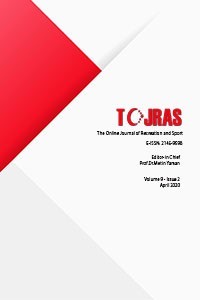Erdal ZORBA, Metin YAMAN, Fatmanur ER, Ceren SUVEREN, Ozan SEVER, Akan BAYRAKDAR, Süleyman GÖNÜLATEŞ
EXAMINATION OF REACTION TIME AND BALANCE RELATION IN CHILDREN BETWEEN THE AGES 9-13
EXAMINATION OF REACTION TIME AND BALANCE RELATION IN CHILDREN BETWEEN THE AGES 9-13
The aim of this study was to explain the relationship between reaction times rightleft hand visual and auditory and balance static balance in children between the ages 9-13. 74 male and 46 female, as a total of 120 students between the ages 9-13 from Ankara Batı College were voluntarily participated in this study. Visual and auditory reaction times were measured by Newtest 1000 reaction timer and Flamingo Balance Test was used to test static balance of players.The data was analyzed by using “Non-parametric Spearman Correlation Test” in SPSS software.The average visual reaction time of subjects for right and left hand were 448,33 ± 156,05 msec and 447,88 ± 142,70 msec respectively, Right and left subjects’ auditory reaction time was 451,95± 166,83 msec and 460,48± 166,24. Right and left dynamic balance scores were obtained 30,37 ± 38,23 sec and 30,72 ± 41,84 sec. respectively. As a result of the research subjects' reaction to the right visual balance with the right r =- 212; p
Keywords:
Children, reaction time, balance, exercise,
___
- Altay, F. (2001). Ritmik cimnastikte iki farklı hızda yapılan chaine rotasyon sonrası yan denge hareketinin biyomekanik analizi. Hacettepe Üniversitesi.
- Arslanoğlu, E., Aydoğmuş, M., Arslanoğlu, C., & Şenel, Ö. (2010). The Relationship Between Reaction Times And Balance In Elite Badminton Players. Niğde Üniversitesi Beden Eğitimi Ve Spor Bilimleri Dergisi Cilt Nigde University Journal of Physical Education And Sport Sciences, 4(2).
- Colakoglu, T., Er, F., Ipekoglu, G., Karacan, S., Colakoglu, F. F., & Zorba, E. (2014). Evaluation of Physical, Physiological and Some Performance Parameters of the Turkish Elite Orienteers. http://doi.org/10.1016/j.sbspro.2014.09.220 - Social and Behavioral Sciences, 152, 403–408.
- Cuisinier, R., Olivier, I., Vaugoyeau, M., Nougier, V., & Assaiante, C. (2011). Reweighting of Sensory Inputs to Control Quiet Standing in Children from 7 to 11 and in Adults. PLoS ONE, 6(5), e19697. http://doi.org/10.1371/journal.pone.0019697
- Çakiroğlu, T., Sökmen, T., & Arslanoğlu, E. (2013). Judo Teknik Antrenmanı ve Oyunlarının 8-10 Yaş Grubu Erkek Çocukların Fiziksel Gelişim Düzeyleri Üzerine Etkisi. Ankara Üniv Spor Bil Fak, 11(2), 73–79.
- Erkmen, N. (2006). Sporcuların Denge Performaslarının Karşılaştırılması. Gazi University.
- Ihira, H., Furuna, T., Makizako, H., & Miyabe, Y. (2009). Relationship between Task Difficulty and Probe Reaction Time in Postural Control. Rigakuryoho Kagaku, 24(5), 727–732. http://doi.org/10.1589/rika.24.727
- Iida, Y., Miyazaki, M., & Uchida, S. (2010). Developmental changes in cognitive reaction time of children aged 6–12 years. European Journal of Sport Science, 10(3), 151–158. http://doi.org/10.1080/17461390903515162
- Kiselev, S., Espy, K. A., & Sheffield, T. (2009). Age-related differences in reaction time task performance in young children. Journal of Experimental Child Psychology, 102(2), 150– 166.
- Mickle, K. J., Munro, B. J., & Steele, J. R. (2011). Gender and age affect balance performance in primary school-aged children. Journal of Science and Medicine in Sport, 14(3), 243–248. http://doi.org/10.1016/j.jsams.2010.11.002
- Polat, G. (2009). 9-12 Yaş Grubu Çocuklarda, 12 Haftalık Badminton Temel Eğitim Antrenmanlarının Motorik Fonksiyonları ve Reaksiyon Zamanları Üzerine Etkisi. Çukurova University.
- Tudor, B., & Gregory, H. (2006). Periodization: Theory and Methodology of Training (4th ed.). Illinois: Human Kinetics.
- Vuillerme, N., & Nougier, V. (2004). Attentional demand for regulating postural sway: The effect of expertise in gymnastics. Brain Research Bulletin, 63(2), 161–165. http://doi.org/10.1016/j.brainresbull.2004.02.006
- ISSN: 2146-9598
- Yayın Aralığı: Yılda 4 Sayı
- Başlangıç: 2012
- Yayıncı: METİN YAMAN
